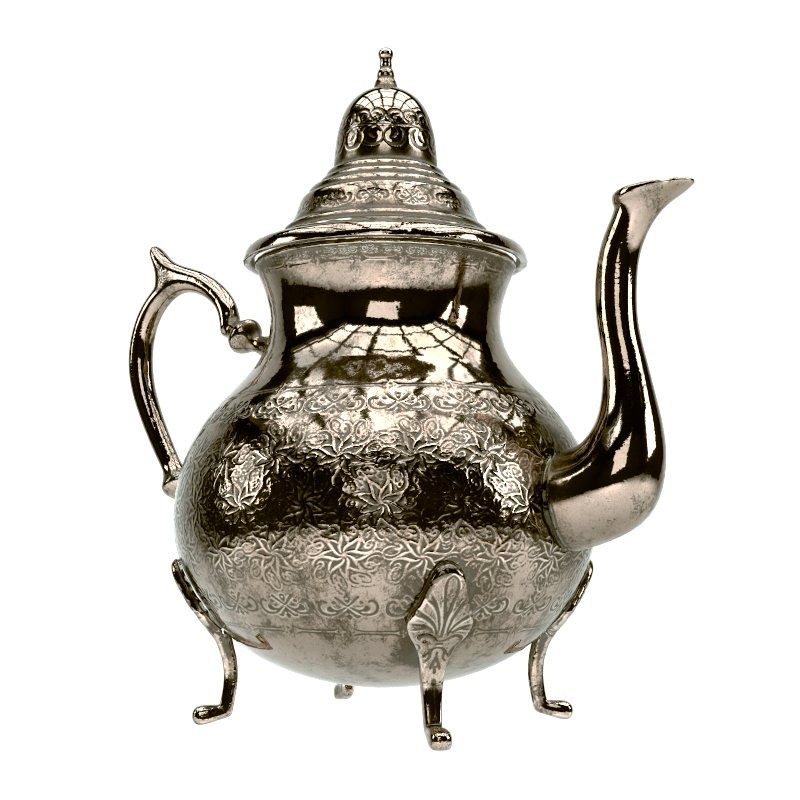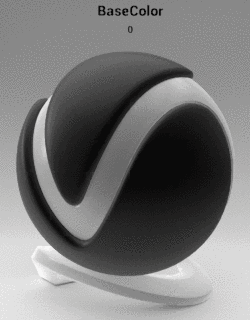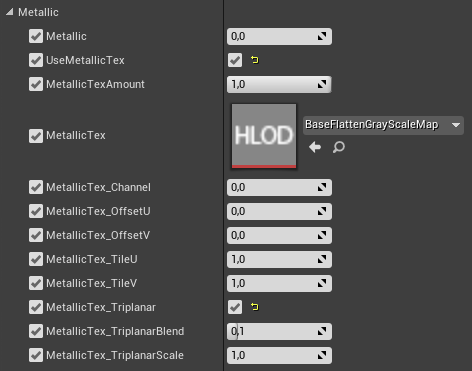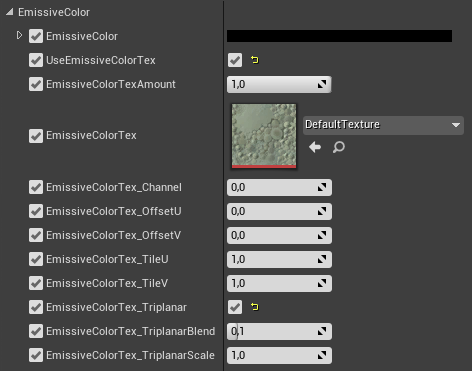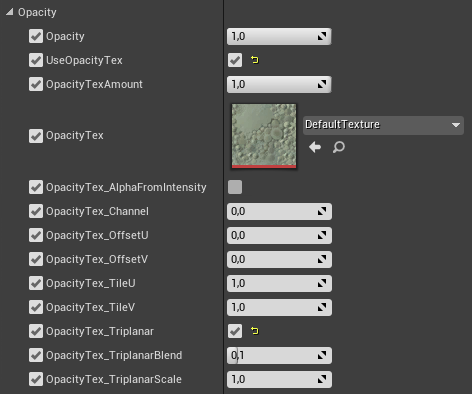This page provides an overview of the VRayPBRMtl and its parameters.
Overview
UI Paths
You can create a VRayPBRMtl through the ||Content Browser|| > Add New > V-Ray > VRayPBRMtl or from ||Content Browser|| > Add New > V-Ray > VRay Material Instance > Parent Material > VRayPBRMtl .
||Content Browser|| > Add New > V-Ray > VRayPBRMtl
||Content Browser|| > Add New > V-Ray > VRay Material Instance > Parent Material > VRayPBRMtl
In order to select VRayPBRMtl as a Parent material you have to first make the plugin folder VRayForUnreal visible. Enable Show Engine Content and Show Plugin Content in the View Options of the Content Browser. Then the VRay Materials will be listed in the Parent dropdown menu.
When VRayPBRMtl is assigned as a Parent and you want to create a solid material with no refractive, transparent or translucent properties, change the Blend Mode in the Material Property Overrides to Opaque.
To create a VRayPBRMtl you have to first make a V-Ray Material Instance material and then assign the VRayPBRMtl as a Parent material.
In order to select VRayPBRMtl as a Parent material you have to first make the plugin folder VRayForUnreal visible. Enable Show Engine Content and Show Plugin Content in the View Options of the Content Browser. Then the VRay Materials will be listed in the Parent dropdown menu.
For your materials to work properly at render time make sure your textures have a valid file path (Source File in the texture Details panel). V-Ray loads the textures from that directory during rendering. If the texture is not found at the specified location, V-Ray will automatically export the texture. You can then find it in your project folder > Content > Texture Cache.
VRayPBRMtl Parameters
BaseColor
Defines the overall color of the material.
BaseColor – Specifies the base color of the material.
UseBaseColorTex – Enables the use of Texture for base color.
BaseColorTexAmount – Specifies the blend amount between BaseColorTex and BaseColor.
BaseColorTex – Specifies the base color Texture when UseBaseColorTex is enabled.
BaseColorTex_Channel – Specifies the UV channel index for the BaseColorTex.
BaseColorTex_OffsetU – Specifies the horizontal offset of the BaseColorTex.
BaseColorTex_OffsetV – Specifies the vertical offset of the BaseColorTex.
BaseColorTex_TileU – Specifies the horizontal repetition of the BaseColorTex.
BaseColorTex_TileV – Specifies the vertical repetition of the BaseColorTex.
BaseColorTex_Triplanar – Enables triplanar option for the BaseColorTex.
BaseColorTex_TriplanarBlend – Specifies the blend amount between the different Texture projections. Lower values produce sharper transitions between projections.
BaseColorTex_TriplanarScale – Adjusts the scale of the BaseColorTex when BaseColorTex_Triplanar is enabled.
Metallic=0; Specular=0.5; Roughness=0.5
Metallic
Controls how metal-like your surface will be.
- Metallic – Specifies the metallic value for the material. Non-metals have Metallic values of 0, metals have Metallic values of 1.
- UseMetallicTex – Enables the use of Texture for metallicness.
- MetallicTexAmount – Specifies the blend amount between MetallicTex and Metallic.
- MetallicTex – Specifies the metallic Texture when UseMetallicTex is enabled.
- MetallicTex_Channel – Specifies the UV channel index for the MetallicTex.
- MetallicTex_OffsetU – Specifies the horizontal offset of the MetallicTex.
- MetallicTex_OffsetV – Specifies the vertical offset of the MetallicTex.
- MetallicTex_TileU – Specifies the horizontal repetition of the MetallicTex.
- MetallicTex_TileV – Specifies the vertical repetition of the MetallicTex.
- MetallicTex_Triplanar – Enables triplanar option for the MetallicTex.
- MetallicTex_TriplanarBlend – Specifies the blend amount between the different Texture projections. Lower values produce sharper transitions between projections.
- MetallicTex_TriplanarScale – Adjusts the scale of the MetallicTex when MetallicTex_Triplanar is enabled.
BaseColor=0.65,0.42,0.04; Specular=0.5; Roughness=0
Specular
Specifies the current amount of specularity on non-metallic surfaces. It has no effect on metals.
- Specular – Specifies the specular value.
- UseSpecularTex – Enables the use of Texture for specular.
- SpecularTexAmount – Specifies the blend amount between SpecularTex and Specular.
- SpecularTex – Specifies the specular Texture when UseSpecularTex is enabled.
- SpecularTex_Channel – Specifies the UV channel index for the SpecularTex.
- SpecularTex_OffsetU – Specifies the horizontal offset of the SpecularTex.
- SpecularTex_OffsetV – Specifies the vertical offset of the SpecularTex.
- SpecularTex_TileU – Specifies the horizontal repetition of the SpecularTex.
- SpecularTex_TileV – Specifies the vertical repetition of the SpecularTex.
- SpecularTex_Triplanar – Enables triplanar option for the SpecularTex.
- SpecularTex_TriplanarBlend – Specifies the blend amount between the different Texture projections. Lower values produce sharper transitions between projections.
- SpecularTex_TriplanarScale – Adjusts the scale of the SpecularTex when SpecularTex_Triplanar is enabled.
BaseColor=0.65,0.42,0.04; Metallic=0; Roughness=0
Roughness
Specifies the roughness properties of the material surface. A rough material will scatter reflected light in more directions than a smooth material.
- Roughness – Controls how rough is the surface. Roughness of 0 (smooth) is a mirror reflection and roughness of 1 (rough) is completely matte or diffuse.
- UseRoughnessTex – Enables the use of Texture for roughness.
- RoughnessTexAmount – Specifies the blend amount between RoughnessTex and Roughness.
- RoughnessTex – Specifies the roughness Texture when UseRoughnessTex is enabled.
- RoughnessTex_Channel – Specifies the UV channel index for the RoughnessTex.
- RoughnessTex_OffsetU – Specifies the horizontal offset of the RoughnessTex.
- RoughnessTex_OffsetV – Specifies the vertical offset of the RoughnessTex.
- RoughnessTex_TileU – Specifies the horizontal repetition of the RoughnessTex.
- RoughnessTex_TileV – Specifies the vertical repetition of the RoughnessTex.
- RoughnessTex_Triplanar – Enables triplanar option for the RoughnessTex.
- RoughnessTex_TriplanarBlend – Specifies the blend amount between the different Texture projections. Lower values produce sharper transitions between projections.
- RoughnessTex_TriplanarScale – Adjusts the scale of the RoughnessTex when RoughnessTex_Triplanar is enabled.
BaseColor=0.65,0.42,0.04; Metallic=1;
EmissiveColor
Specifies the emissive properties of the material.
- EmisiveColor – Controls the emission of the surface.
- UseEmissiveColorTex – Enables the use of Texture for emission.
- EmissiveColorTexAmount – Specifies the blend amount between EmissiveColorTex and EmissiveColor.
- EmissiveColorTex – Specifies the emissive Texture when UseEmissiveColorTex is enabled.
- EmissiveColorTex_Channel – Specifies the UV channel index for the EmissiveColorTex.
- EmissiveColorTex_OffsetU – Specifies the horizontal offset of the EmissiveColorTex.
- EmissiveColorTex_OffsetV – Specifies the vertical offset of the EmissiveColorTex.
- EmissiveColorTex_TileU – Specifies the horizontal repetition of the EmissiveColorTex.
- EmissiveColorTex_TileV – Specifies the vertical repetition of the EmissiveColorTex.
- EmissiveColorTex_Triplanar – Enables triplanar option for the EmissiveColorTex.
- EmissiveColorTex_TriplanarBlend – Specifies the blend amount between the different Texture projections. Lower values produce sharper transitions between projections.
- EmissiveColorTex_TriplanarScale – Adjusts the scale of the EmissiveColorTex when EmissiveColorTex_Triplanar is enabled.
BaseColor=0.65,0.42,0.04; Specular=0.5; Metallic=0; Roughness=1
Opacity
Specifies the opacity of the material.
Opacity – Specifies the amount of opacity. Any value below one will enable refraction.
UseOpacityTex – Enables the use of Texture for opacity.
OpacityTexAmount – Specifies the blend amount between OpacityTex and Opacity.
OpacityTex – Specifies the opacity Texture when UseOpacityTex is enabled.
OpacityTex_AlphaFromIntensity – When enabled opacity will be set from the RGB intensity of the OpacityTex. When disabled opacity will be set from the alpha channel of the OpacityTex.
OpacityTex_Channel – Specifies the UV channel index for the OpacityTex.
OpacityTex_OffsetU – Specifies the horizontal offset of the OpacityTex.
OpacityTex_OffsetV – Specifies the vertical offset of the OpacityTex.
OpacityTex_TileU – Specifies the horizontal repetition of the OpacityTex.
OpacityTex_TileV – Specifies the vertical repetition of the OpacityTex.
OpacityTex_Triplanar – Enables triplanar option for the OpacityTex.
OpacityTex_TriplanarBlend – Specifies the blend amount between the different Texture projections. Lower values produce sharper transitions between projections.
OpacityTex_TriplanarScale – Adjusts the scale of the OpacityTex when OpacityTex_Triplanar is enabled.
BaseColor=0.65,0.42,0.04; Metallic=0; Specular=0.5; Roughness=0.5
NormalTex
Specifies the normal bump to the material.
UseNormalTex – Enables the use of Texture for normal bump.
NormalTexAmount – Specifies the normal bump amount.
NormalTex – Specifies the normal Texture when UseNormalTex is enabled.
NormalTex_Channel – Specifies the UV channel index for the NormalTex.
NormalTex_OffsetU – Specifies the horizontal offset of the NormalTex.
NormalTex_OffsetV – Specifies the vertical offset of the NormalTex.
NormalTex_TileU – Specifies the horizontal repetition of the NormalTex.
NormalTex_TileV – Specifies the vertical repetition of the NormalTex.
NormalTex_Triplanar – Enables triplanar option for the NormalTex.
NormalTex_TriplanarBlend – Specifies the blend amount between the different Texture projections. Lower values produce sharper transitions between projections.
NormalTex_TriplanarScale – Adjusts the scale of the NormalTex when NormalTex_Triplanar is enabled.
BaseColor=0.65,0.42,0.04; Metallic=1; Roughness=0.2
BumpTex
Specifies the bump properties to the material.
UseBumpTex – Enables the use of Texture for bump.
BumpTexAmount – Specifies the bump amount.
BumpTex – Specifies the bump Texture when UseBumpTex is enabled.
BumpTex_Channel – Specifies the UV channel index for the BumpTex.
BumpTex_OffsetU – Specifies the horizontal offset of the BumpTex.
BumpTex_OffsetV – Specifies the vertical offset of the BumpTex.
BumpTex_TileU – Specifies the horizontal repetition of the BumpTex.
BumpTex_TileV – Specifies the vertical repetition of the BumpTex.
BumpTex_Triplanar – Enables triplanar option for the BumpTex.
BumpTex_TriplanarBlend – Specifies the blend amount between the different Texture projections. Lower values produce sharper transitions between projections.
BumpTex_TriplanarScale – Adjusts the scale of the BumpTex when BumpTex_Triplanar is enabled.
BaseColor=0.65,0.42,0.04; Metallic=1; Roughness=0.2

